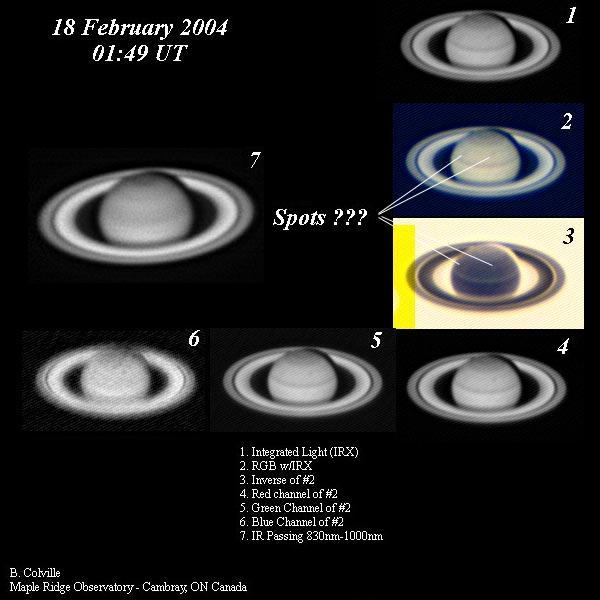| Kenji Nakai( LX200-25(254mmF10SC) , ToUcam Pro) |

2004/02/18 13:43:59(UT) I=107.5 III=117.8 LX200GPS-25(254mm Schmidt Cassegrain f/10) LE7.5mm+IR-cut+pentaprism+ToUcam Pro exp.:1/25sec. 1516frames seeing:3/10 transp.:3/5 comment: 眼視ではseeing:4-5/10なので撮影準備をしている うちにseeing:3/10に落ちてしまった。最近西空は 何故かseeingが悪い。 ≪広島市 中井健二≫
| Toshihiko Ikemura (310mm Newton, Philips ToUcam PRO) |

poor seeing 5/10 12日よりシーイングが良いと思ったが、それほどでもなかった。 EZから南極に向かって アイボリ、茶色の筋、ピンク、黄色、茶色、こげ茶色 茶色の筋、を除いて5段階の層に色分けになっているが、 黄色が狭くなったような気がします。 緯度が高くなったか、南極の茶色の部分が広がったのか どちらでしょう。 [T.Ikemura Nagoya Aichi JAPAN] ≪愛知県名古屋市 池村俊彦≫
| Kenkichi.Yunoki (200mm Newtonian, ToUcam Pro) |

[Kenkichi Yunoki (Sakai City Japan)] ≪大阪府 堺市 柚木健吉≫
| Brian Colville(300mm F10 Schmidt-Cass:ToUcam Pro) |

You will find a pair of dark spots on the images which are easily visible in the RGB image as well as its inverse. I am unsure if these are true spots, since the images were not flat fielded and I cannot shoot one now since the camera has been moved since this image was taken.
I have also split the RGB channels and processed the colour video clip as a monochrome frame. An IR rejection filter was used for the clip. It was assembled from 700 frames from a 1800 frame clip using Registax.
The telescope was the 30cm SCT @ f24 and I used the ToUcam Pro in 320x240 mode to grab the video. The IR frame was taken with the same telescope, but the projection distance is a bit longer giving f27. I use the Pixcel 237 in hi-res mode (7.4u pixels), and used Registax to assemble 12 of 20 raw frames (3 sec each) to create the IR image. I do not believe the spots are visible in the IR frame.
Unfortunately, I do not have a CM calculated for the date and time of the image.
What do you think...spots or dust bunnies??? Questions and comments would be greatly appreciated.
[ Brian Colville : Cambray Canada]
 ALPO-Japan Latest
ALPO-Japan Latest

 Saturn Section
Saturn Section